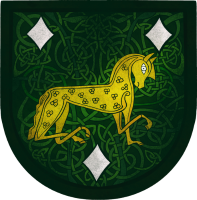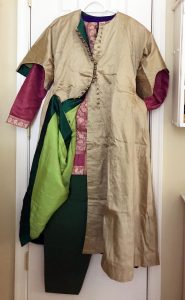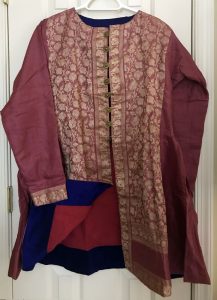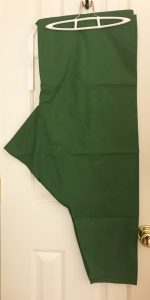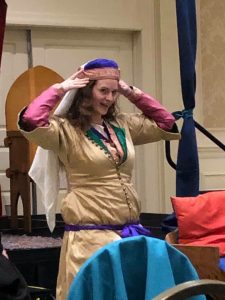
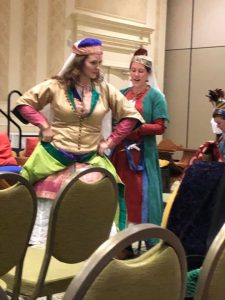 In 2019, I decided to make Ottoman Turkish garb for a Near-East-themed Twelfth Night — and won for Best Themed Garb in the Garb Runway Competition! I unfortunately got almost no pictures from the event, but below the cut I have my full documentation, progress photos, and pictures of the finished garb.
In 2019, I decided to make Ottoman Turkish garb for a Near-East-themed Twelfth Night — and won for Best Themed Garb in the Garb Runway Competition! I unfortunately got almost no pictures from the event, but below the cut I have my full documentation, progress photos, and pictures of the finished garb.
Süslü Kadın
16th Century Ottoman Turkish Garb
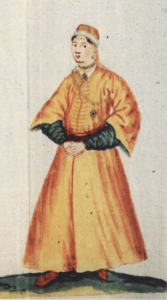
Finished Garb
|
|
|
|
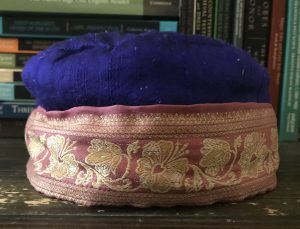
Items, Patterns, and Materials
Items are listed skin-out.
Çakşir (pants)
- Pattern: Adapted from şalwar patterns by Lady Faye de Trees and Master Rashid
- Materials: cotton
Gömlek (chemise)
- Pattern: Lady Faye de Trees
- Materials: linen, freshwater pearl button, lucetted linen for button-loop
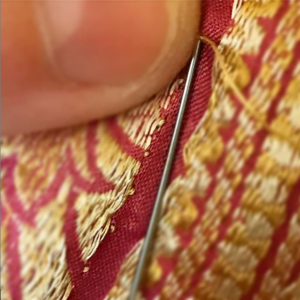
Zıbın (short jacket)
- Pattern: Lady Faye de Trees
- Materials: silk, cotton, vintage metal buttons, flat cording for button-loops
Kaftan (long coat)
- Pattern: Lady Faye de Trees
- Materials: silk, vintage metal buttons, flat cording for button-loops
Tarpuş (hat) with kaşbasti (veilband) and veil
- Pattern: Personal, made with reference to a modern Libyan felted tarboosh and “The Two-Hour Tarpuş” handout by Lady Alisandre de la Chapelle
- Materials: wool (base), silk, linen
Techniques and Construction
- 100% handsewn
- Threads are cotton-on-cotton and silk-on-silk
- The thread for the linen gömlek is warp threads from the fabric
- Backstitched in areas of greater stress
What I Love
- POCKETS! Amani Bey hypothesized that the hip-bumps in kaftans concealed pockets, and I loved the idea so much that I added them in.
- Fabrics and colors! All the colors are period, as are the fabrics, and I am in love.
- Lining with silk! The kaftan’s silk lining makes it incredibly easy to put on.
- My hat is full of secrets! the wool used to sew the base is fabric that I handwove as an experiment, using handspun by a friend (also an experiment). The final fabric wasn’t very pretty, but it makes a very nice hat base!
What I Would Change
- Çakşir (pants): Make my own pattern based on period examples. This is the second time I have adapted patterns for these; each time I’ve had to make significant adjustments (such as removing length or adding a gusset). I also plan to inkle-weave a drawstring.
- Zıbın (short jacket): Buy patterned fabric that’s the right size! Because I was reclaiming a sari, I had to piece the fabric to get enough for the front, which made fitting a little bit more challenging.
- I need to take more in-construction pictures!
- I want to invest in proper shoes!
Period Exemplars
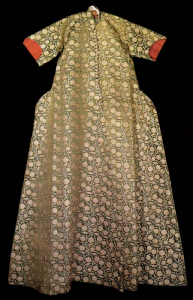
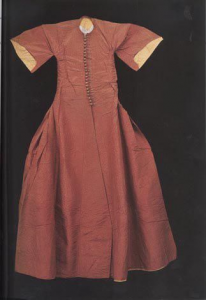
I relied strongly on Issendai’s Ottoman Turkish Garment Database for exemplars. These two kaftans in particular pieces inspired colors, fabric, and construction.

Sources
Lady Alisandre de la Chapelle. “The Two-Hour Tarpuş.” Running with Scissors (and Fabric), http://runningwithscissorsandfabric.blogspot.com/2018/07/the-two-hour-tarpush.html.
Lady Faye de Trees. “Ottoman Turkish Clothing.” Tastefully Timeless, https://tastefullytimeless.com/sample-page/1500s-sixteenth-century/ottoman-turkish-clothing/
Issendai. 16th-Century Istanbul, http://www.issendai.com/16thcenturyistanbul/womens-garb-piece-by-piece/
Issendai. Ottoman Turkish Garment Database, http://issendai.com/ottoman-turkish/
Master Rashid. “Salwar.” Dar Anahita, http://home.earthlink.net/~lilinah/Rashid/salwar.gif
SCA Ottoman Clothing and Culture Facebook group.
